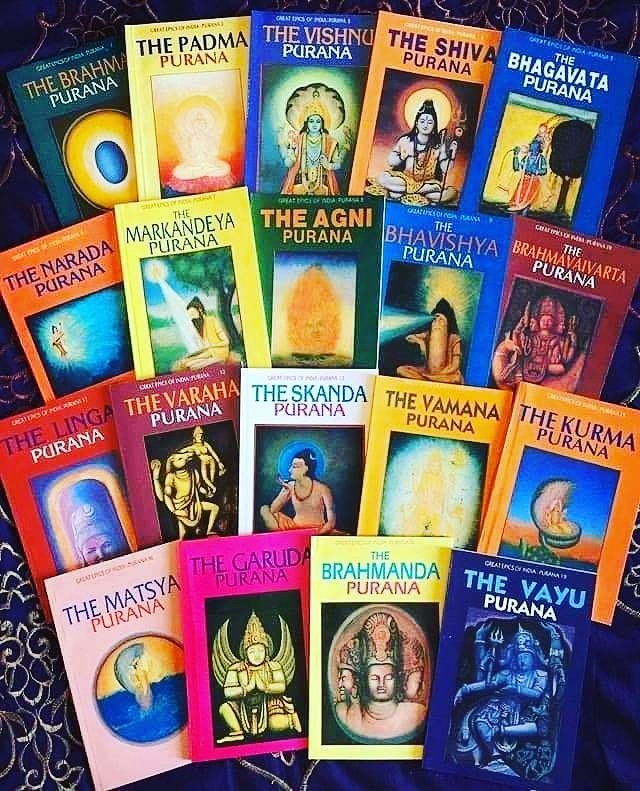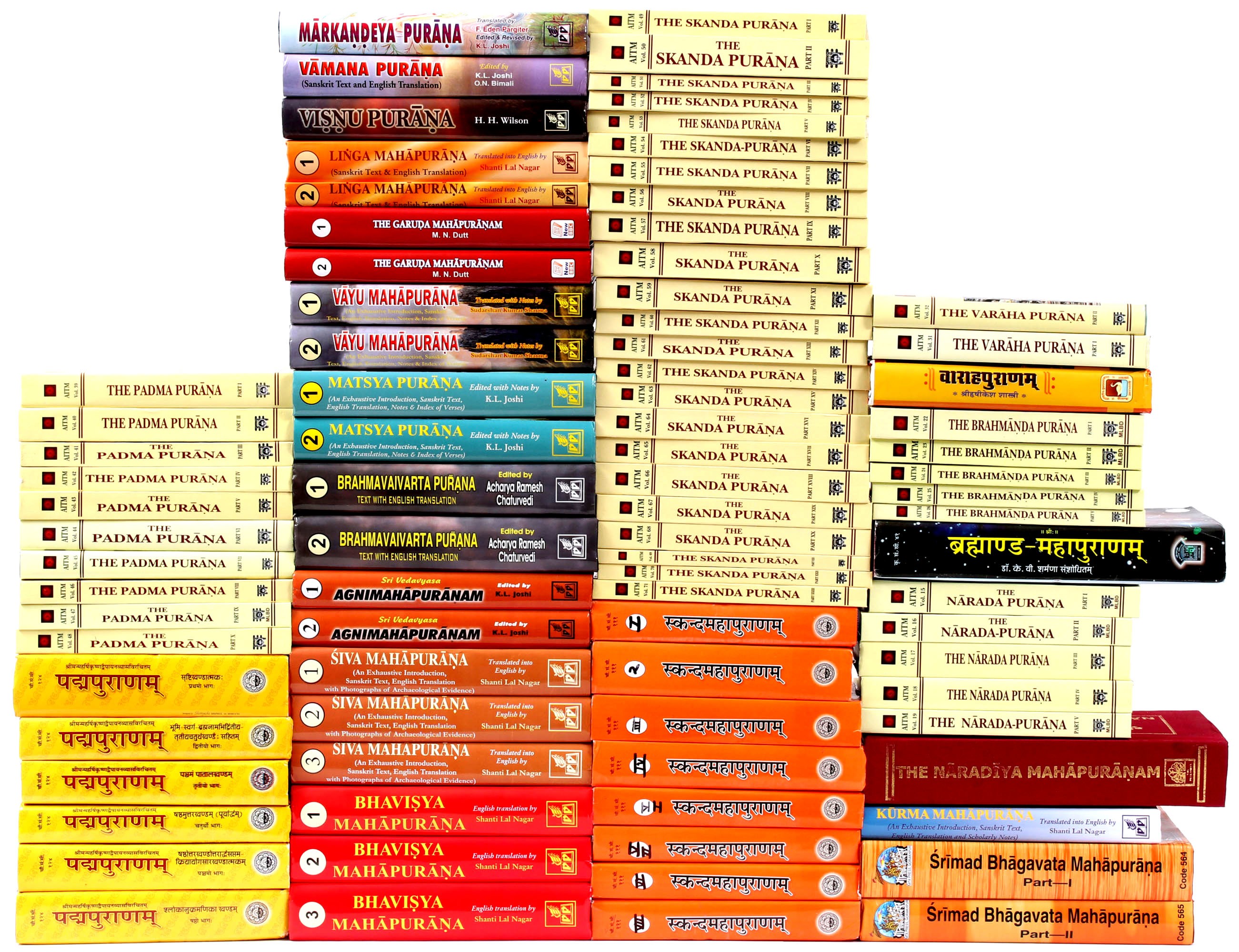The Origin & Importance of The Puranas


Among the great personalities who came to worship the lotus feet of the Lord were those who had attained perfection in self-control and regulative principles, as well as experts in logic, history, general education and the Vedic literature known as Purana.
Others were experts in the Vedic corollaries like Brahma-saṁhitā, all the other knowledge of the Vedas [Sāma, Yajur, Ṛg and Atharva], and also the supplementary Vedic knowledge [Āyurveda, Dhanurveda, etc.].
Others were those who had been freed of the reactions to fruitive activities by transcendental knowledge awakened by practice of yoga. And still others were those who had attained residence in Brahmaloka not by ordinary karma but by advanced Vedic knowledge. After devotedly worshiping the upraised lotus feet of the Supreme Lord with oblations of water, Lord Brahmā, who was born of the lotus emanating from Lord Viṣṇu’s navel, offered prayers to the Lord.
– Srimad Bhagavatam 8.21.2-3
This verse from the Srimad Bhagavatam has stated the origin of the Puranas and with the story of their origin, we now also know of their importance, now let’s see the characteristics of a Purana.
O brāhmaṇa, authorities on the matter understand a Purāṇa to contain ten characteristic topics :-
The creation of this universe,
The subsequent creation of worlds and beings,
The maintenance of all living beings and their sustenance,
The rule of various Manus, the dynasties of great kings and the activities of such kings,
Annihilation, Motivation and the Supreme Shelter.Other scholars state that the Great Puranas deal with these ten topics, while Lesser Puranas may deal with five.
– Srimad Bhagavatam 12.7.9 – 10
Thus, this verse from the Srimad Bhagavatam has also told the characteristics of the Puranas and the Upa-Puranas. Now let’s see how many Puranas there are, in chronological order.
The first Purāṇa is Brāhma; the second is said to be Pādma; the third one is Vaishnava (Vishnu Purana); the fourth one is said to be Shaiva (Shiva Purana); the fifth is said to be Bhāgavata. Bhavishya is said to be the sixth; Nāradīya is declared to be the seventh; Mārkaṇḍeya is said to be the eighth; the ninth is Āgneya (i.e. Agni Purāṇa); Brahmavaivarta is said to be the tenth; then Laiṅga (i.e. Linga Purana), Vāmana, Skānda (i.e. Skanda Purāṇa), Mātsya (i.e. Matsya Purāṇa), Kaurma (i.e. Kūrma Purāṇa); Vārāha (i.e. Varāha Purāṇa) is also said (to be one of the Purāṇas); Gāruḍa (i.e. Garuḍa Purāṇa) is also said (to be a Purāṇa); so also Brahmāṇḍa Purāṇa. Thus the wise know the Purāṇas to be Eighteen.
– Padma Purana 5.115.89-93a
Let’s also look at the list of the Upa-Puranas.
Similarly I shall tell about the Upapurāṇas hereafter. The first one is Sanatakumāra; after that (comes) Nārasiṃha; the third one is said to be Māṇḍa; then there is Daurvāsasa (i.e. Durvāsas); then Nāradīya; the next is Kāpila; then is Mānava; then is said to be Auśanasa; then comes Brahmāṇḍa; then there is Vāruṇa; there is one called Kālikā; so also there are Māheśa and Sāmba, Saura and Pārāśara, Mārīca, and the one called Bhārgava; so also Kaumāra. ( These are said to be eighteen Upapurānas. Manu would be the expounder of the eighteen Purānas.
– Padma Purana 5.115.93b-97
Now, let’s see how many verses each of the Puranas contain, to see which one is longest and which one is the shortest, and what’s the sum total of their verses.
The Brahma Purāṇa consists of ten thousand verses, the Padma Purāṇa of fifty-five thousand, Śrī Viṣṇu Purāṇa of twenty-three thousand, the Śiva Purāṇa of twenty-four thousand and Śrīmad-Bhāgavatam of eighteen thousand.
The Nārada Purāṇa has twenty-five thousand verses, the Mārkaṇḍeya Purāṇa nine thousand, the Agni Purāṇa fifteen thousand four hundred, the Bhaviṣya Purāṇa fourteen thousand five hundred, the Brahma-vaivarta Purāṇa eighteen thousand and the Liṅga Purāṇa eleven thousand.
The Varāha Purāṇa contains twenty-four thousand verses, the Skanda Purāṇa eighty-one thousand one hundred, the Vāmana Purāṇa ten thousand, the Kūrma Purāṇa seventeen thousand, the Matsya Purāṇa fourteen thousand, the Garuḍa Purāṇa nineteen thousand and the Brahmāṇḍa Purāṇa twelve thousand.
Thus the total number of verses in all the Puranas is Four Hundred Thousand. Eighteen thousand of these, once again, belong to the beautiful Bhāgavatam.– Srimad Bhagavatam 12.13.4 – 9
Now that we have known number of verses on the Puranas, we know very well that these Puranas contain a lot of knowledge, and they are simply a vast ocean of knowledge. But, at the end of the day, each and every Purana is a body part of Shri Hari Vishnu, as he contains all this knowledge within himself.
Thus is the greatness of that highest Lord Vishnu, taking up many forms, who is the cause of complete liberation in the world. One of the forms is the great Padma Purāna. The Brahma Purāṇa is the head of Vishnu only. His heart is called Padma.
The Vishnu Purāṇa is his right arm. The Śaiva Purāṇa is the left arm of the great lord. The Bhāgavata Purāṇa is said to be his thighs. The Nāradīya Purāṇa is his navel. The Mārkaṇḍeya Purāṇa is his right foot; the Agni Purāṇa is said to be his left foot. The Bhaviṣya Purāṇa is the right knee of the magnanimous Vishnu only.
The Purāṇa called Brahmavaivarta is said to be his left knee. The Liṅga Purāṇa is said to be the right ankle and the Varāha is the left ankle. The Skanda Purāṇa is the hair, and the Vāmana Purāṇa is said to be his skin. The Kūrma Purāṇa is said to be his back; the Matsya is said to his fat. The Garuḍa Purāṇa is said to be his marrow; the Brahmāṇḍa is said to be his bone(s). Thus Vishnu was having the Purāṇas as parts of his body. Padma there is the heart, having heard which a man obtains nectar.
– Padma Purana Svarga Khanda Chapter 62 Verse 1 – 8a
So all the Puranas are very important as they contain tremendous amount of information and knowledge about all subjects, and also because they have emerged from Shri Hari, and they are indeed a literary incarnation of him, so whoever reads the Puranas, will get transcendental bliss and a feeling of Bhakti.
And now that we know the importance of the Puranas, let us read them!
Srimad Bhagavatam :- https://vedabase.io/en/library/sb/
Markandeya Purana :- https://www.wisdomlib.org/hinduism/book/the-markandeya-purana
Padma Purana :- https://www.wisdomlib.org/hinduism/book/the-padma-purana
Kurma Purana :- https://archive.org/details/kurma-purana-full-parts-1-and-2/page/n1/mode/2up
Vayu Purana :- https://archive.org/details/VayuPuranaG.V.TagarePart1/page/n61/mode/2up https://archive.org/details/VayuPuranaG.V.TagarePart2/page/n5/mode/2up
Harivamsa Purana :- https://www.tititudorancea.com/z/harivamsa.htm
Garuda Purana :- https://archive.org/details/GarudaPuranamSanskritEnglish/page/n3/mode/2up https://archive.org/details/GarudaPuranaEnglishMotilal3VolumesIn1/page/n1/mode/2up
Brahma Purana :- https://archive.org/details/dli.bengal.10689.20566/page/n5
Brahma-vaivarta Purana :- https://archive.org/details/brahma-vaivarta-purana-all-four-kandas-english-translation/mode/2up
Vishnu Purana :- https://archive.org/details/vishnu-purana-sanskrit-english-ocr
Varaha Purana :- https://archive.org/details/toaz.info-varaha-purana-unabridged-motilal-englishpdf-pr_e1d9a18739bfe3dd54249588e67c9ece
Narsimha Upapurana :- https://archive.org/details/toaz.info-narasimha-purana-with-english-translationpdf-pr_d45298a415483199283c13ad3208d5e4
Kalki Upapurana :- https://om-aditya.ru/userfiles/ufiles/purany/sri_kalki_purana.pdf
Shiva Purana :- https://www.wisdomlib.org/hinduism/book/shiva-purana-english
Skanda Purana :- https://www.wisdomlib.org/hinduism/book/the-skanda-purana
Narada Purana (In 5 Volumes) :- https://drive.google.com/drive/folders/0Bwu-vE3n9ze9aVlXXzQ1NDk4RUU?resourcekey=0-wmjfOsVHfP8HI8bKdFvzUQ
Brahmanda Purana :- https://www.wisdomlib.org/hinduism/book/the-brahmanda-purana
Linga Purana :- https://archive.org/details/LingaPuranaJ.L.ShastriPart1/page/n5/mode/2up , https://archive.org/details/LingaPuranaJ.L.ShastriPart2/page/n3/mode/2up
Devi Bhagavata Purana :- https://www.wisdomlib.org/hinduism/book/devi-bhagavata-purana
Agni Purana :- https://www.wisdomlib.org/hinduism/book/the-agni-purana

Have A Nice Read!
DISCLAIMER: The author is solely responsible for the views expressed in this article. The author carries the responsibility for citing and/or licensing of images utilized within the text.
